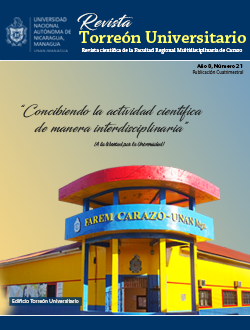Carbapenemase-producing Pseudomonas aeruginosa from Managua, Nicaraguan hospitals
DOI:
https://doi.org/10.5377/torreon.v8i21.8851Keywords:
Pseudomonas, resistance, carbapenemasaAbstract
The current study was presented to know the frequency of Pseudomonas aeruginosa metallo-β-lactamasas and resistance patterns in hospitalized patients. For this, a cross-sectional study was carried out in the period of July 2016, January 2017. The strains were obtained from the different infectious processes of hospitalized patients, strains were preserved in milk broth in hospitals until their subsequent analysis, the strains were reactivated in MacConkey agar, a screening was carried out by the method of Kirby Bauer, the cut-off value was taken, when Imipenem and Meropenem was ≤21mm, the synergy test was determined, using carbapenemics and their inhibitors, ethylenediaminetetraacetic acid (10ᶙg) and phenyl boronic acid (10 µg), the resistance profile was performed using vitek2 Compact, the minimum inhibitory concentration was determined for Imipenem 2-4 µg / ml and for Ertapenem 2 µg / ml, genotyping was determined by Reaction in Polymerase chain and molecular weight was determined by electrophoresis.
The universe was comprised of 288 strains, of these 22 were Pseudomonas aeruginosa, which corresponded to 7.6%, the strains analyzed presented multi-resistance to the various antibiotics analyzed, only 7 (32%), resistance to tigecycline and none of the strains present resistance to Colistin, the most frequently genes was VIM, for 68%, the most frequently type of sample, where Pseudomonas was isolated, was tracheal samples, 7 (32%), followed by secretion 5 (23%), Blood culture 1 (4%), catheter tip 4 (18%), and the most frequent rooms where these microorganisms were present, was a pediatric ICU with 91%.
As a result of the study, it is concluded that the prevalence of Pseudomonas aeruginosa, producers of carbapenemases, in hospitals in Nicaragua, is low, but should be of concern for hospital authorities, because the strains contain various types of genes combined as; VIM and GIM, VIM and SPM, which can trigger epidemic outbreaks, the frequency with which new strains resistant to carbapenems appears is evident, this evidence involves the search for strategies, to avoid the dispersion of multiresistant strains in different health units at the time of transfer of a carrier patient to another hospital unit.
Downloads
1108
PDF 262
HTML (Español (España)) 607
HTML 172
Downloads
Published
How to Cite
Issue
Section
License
Los autores que publican en esta revista están de acuerdo con los siguientes términos.
- El autor o los autores de los artículos, ensayos o investigaciones conceden a la Universidad Nacional Autónoma de Nicaragua, Managua (UNAN-Managua) los derechos de edición (copyright) del trabajo enviado, por consiguiente la Universidad cuenta con el derecho exclusivo para publicar el artículo durante el periodo completo de los derechos de autor.
- Estos derechos de autor/ autores autorizan a la Revista Torreón Universitario y a la Universidad editar y divulgar/publicar el artículo en dicha Revista, incluyendo reproducción impresa y electrónica, el almacenamiento, recuperación y cualquier otro tipo de publicación, y fuentes de información secundaria como servicios de resúmenes y bases de datos, así mismo la facultan a proteger el artículo contra el uso no autorizado para su difusión por medios impresos o electrónicos (PDF, HTML, EPUB, XML u otros).
Licencia para el uso del contenido
La revista hace uso de la Licencia Creative Commons Atribución-NoComercial-SinDerivar 4.0 Internacional.
Bajo esta declaración:

Este revista está sujeta a una licencia de Creative Commons Reconocimiento-NoComercial-SinObraDerivada 4.0 Internacional. Puede ser copiada, distribuida y transmitida públicamente siempre y cuando se cite al autor y la fuente (Revista Torreón Universitario), no debe modificarse ni utilizarse con ningún fin comercial. La licencia completa se puede consultar en http://creativecommons.org/licenses/by-nc-nd/4.0/.



